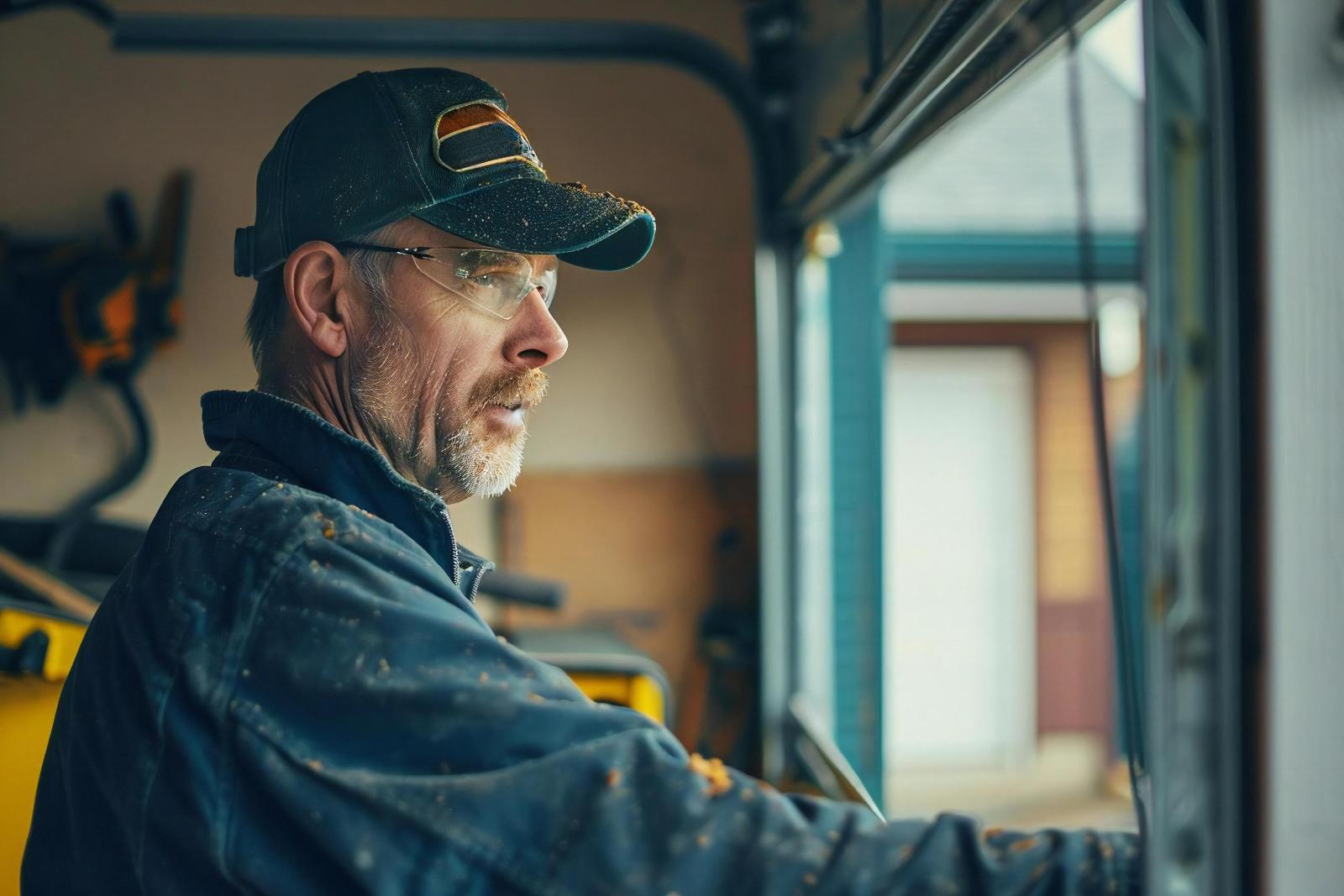Contents
Knowing the right approach is key to a successful outcome when tackling DIY garage door repairs. From safety precautions to essential tools and step-by-step repair instructions, expert advice can make all the difference in your project’s success. But remember, there’s an essential aspect that often gets overlooked, one that could save you time, money, and frustration. Curious to uncover this vital element that can elevate your DIY garage door repair skills?
Key Takeaways
- Wear safety gear for protection during repairs.
- Familiarize yourself with the emergency release function.
- Disconnect power before starting any repair work.
- Secure the repair area to prevent accidents.
- Have a charged phone nearby for emergencies.
Common Garage Door Issues
If you’re experiencing problems with your garage door, identifying common issues is the first step in troubleshooting effectively.
One common issue that you may encounter is related to the sensors of your garage door. These sensors are vital for guaranteeing the safety of your garage door operation. If your garage door isn’t closing properly or is reversing unexpectedly, it might be due to misaligned sensors. To troubleshoot this problem, check if the sensors are properly aligned and free from any obstructions. Adjust the sensors if needed and ensure they face each other directly.
Another essential aspect of garage door maintenance is upgrading security features. With advancements in technology, it’s important to make sure that your garage door security is up to date.
Consider upgrading to a smart garage door opener that offers enhanced security features, such as rolling code technology. This technology changes the access code each time the door is operated, preventing potential intruders from gaining unauthorized access to your garage.
Safety Precautions Before Repair
Before starting any garage door repairs, make sure you have taken the necessary safety precautions to protect yourself and prevent accidents. When dealing with heavy garage doors and complex mechanisms, safety should always be the top priority. Make sure you follow these essential safety measures before starting any repair work:
Safety Gear: Wear appropriate safety gear such as gloves, safety glasses, and closed-toe shoes to protect yourself from potential injuries.
Emergency Preparedness: Familiarize yourself with the garage door’s emergency release function in case it needs to be disengaged during repairs. Have a fully charged phone nearby in case you need to call for help.
Secure the Area: Clear out any obstructions in the vicinity of the garage door to prevent accidents or tripping hazards during the repair process.
Disconnect Power: Before starting any repair work, disconnect the power to the garage door opener to avoid any accidental activations that could lead to injuries.
Tools Needed for DIY Repair
To successfully complete a DIY garage door repair, you’ll need a specific set of tools that are essential for the task at hand. Before you start, make sure your tools are in good condition by performing regular tool maintenance. Inspect them for any signs of wear or damage to guarantee they function properly during the repair process. Proper tool organization is also vital for efficiency; consider using a toolbox or pegboard to keep everything in its place.
When starting on a garage door repair project, safety gear is non-negotiable. Always wear safety goggles to protect your eyes from debris, gloves to shield your hands, and closed-toe shoes for foot protection. These simple precautions can prevent injuries and keep you safe throughout the repair.
As you explore the repair, familiarize yourself with different repair techniques based on the issue at hand. Understanding how to approach common garage door problems such as misaligned tracks, rusty springs, or malfunctioning sensors will equip you with the knowledge needed to tackle the repair effectively.
How to Identify Garage Door Parts
When identifying garage door parts for repair, start by examining the components that make up the door system, such as the springs, tracks, and sensors. Understanding the garage door anatomy is essential for effective troubleshooting.
Here’s how you can identify different components:
Springs: Look for the large springs located above the door. There are typically two types – torsion springs mounted above the door opening or extension springs running along the tracks on either side.
Tracks: Inspect the metal tracks on either side of the door. Check for any bends, dents, or misalignments that may be hindering the smooth operation of the door.
Rollers: Examine the rollers that help the door move along the tracks. Worn-out or damaged rollers can cause the door to operate noisily or get stuck.
Sensors: Locate the safety sensors near the bottom of the door tracks. These sensors are a critical safety feature and should be aligned properly to make sure the door doesn’t close on objects or people.
Step-by-Step Repair Instructions
Begin by gathering the necessary tools and safety equipment before starting the step-by-step repair instructions for your garage door. Safety precautions are paramount. Make sure to disconnect the power to the garage door opener to avoid any accidents.
Common issues you might encounter include misaligned tracks, damaged rollers, or broken springs.
Step by step instructions are vital for a successful garage door repair. Start by inspecting the tracks for any bends or dents. If you notice any, gently hammer them back into place.
Next, lubricate the rollers and tracks to guarantee smooth operation. Tighten any loose hardware that you find along the way.
Repair techniques must be followed precisely. If the garage door is noisy, consider adjusting the tension on the springs. However, be cautious as the springs are under high tension and can be dangerous if mishandled.
If the door still doesn’t function properly, check the balance by disconnecting the opener and manually lifting the door halfway. It should stay in place; if not, adjust the spring tension accordingly.
Tips for Smooth Garage Door Operation
For peak performance, regularly lubricate the garage door rollers and tracks to ensure smooth operation. Proper lubrication techniques are crucial to make certain that your garage door moves effortlessly along the tracks. Use a silicone-based lubricant to guarantee no buildup and corrosion, enhancing the longevity of your door system.
To further enhance your garage door’s operation, consider the following tips:
Inspect and Clean Rollers: Regularly examine the rollers for any signs of wear and tear. Clean them using a mild household cleaner to eliminate dirt and debris that may hinder smooth movement.
Check Track Alignment: Ensure that the tracks are correctly aligned. Misaligned tracks can cause the door to jerk or get stuck. Use a level to verify alignment and adjust if necessary.
Weatherproofing Strategies: Seal any gaps or cracks around the garage door to prevent water or debris from entering. Weatherstripping can help maintain a consistent temperature inside the garage and protect your door components.
Remote Programming Tutorials: Familiarize yourself with the remote programming instructions for your garage door opener. Proper programming ensures that the remote functions smoothly, contributing to the overall operation of your garage door system.
Troubleshooting Garage Door Opener
Regularly evaluate the functionality of your garage door opener to troubleshoot any potential issues that may arise. If you encounter problems with the remote control not working, start by checking the batteries. Weak batteries can cause signal transmission issues. Replace them with fresh ones and test the remote. If the problem persists, make sure there are no obstructions blocking the signal between the remote and the opener.
Another common issue is when the garage door doesn’t close or open fully. This could be due to the travel limits needing adjustment. Locate the adjustment screws on the opener unit. Turn the screw labeled ‘open’ to increase the door’s upward travel or ‘close’ to adjust the downward travel. Make small adjustments, testing the door after each change until it fully opens or closes without any issues.
Additionally, if you notice the garage door opener making unusual noises, inspect the chain or belt for any signs of wear or damage. Lubricate the moving parts as per the manufacturer’s recommendations to reduce friction and noise.
Maintaining Garage Door Springs
To guarantee your garage door springs function smoothly, start by applying lubricant to the springs regularly. Proper spring lubrication helps reduce friction and wear, extending the lifespan of your garage door system.
Additionally, make sure to periodically check and adjust the tension of the springs for peak performance.
Spring Lubrication Tips
Proper spring maintenance is essential for the smooth operation and longevity of your garage door. Regularly lubricate your garage door springs with a high-quality silicone spray.
Follow these lubrication techniques to make sure your springs are in top condition:
Choose the Right Lubricant: Opt for a silicone-based spray specifically designed for garage door springs. Avoid using WD-40 or grease as they can attract dirt and debris, causing more harm than good.
Clean the Springs: Before applying lubricant, make sure to clean the springs thoroughly to remove any existing grime or buildup. This allows the lubricant to penetrate effectively.
Apply Sparingly: Use a moderate amount of silicone spray on the springs, focusing on the coils and hinges. Excess lubricant can lead to dripping and attract more dirt.
Regular Maintenance: Aim to lubricate your garage door springs every six months to keep them functioning smoothly and prevent unnecessary wear and tear. This simple maintenance routine can prolong the lifespan of your springs and save you from costly repairs in the long run.
Spring Tension Adjustment
Maintain proper garage door functionality by adjusting the tension of your springs as needed, an essential maintenance task for peak performance.
When it comes to DIY repair and maintenance tips for your garage door, understanding how to adjust the spring tension is vital. Start by guaranteeing your safety by closing the door and disconnecting the automatic opener.
Use winding bars to adjust the tension, turning them in quarter-turn increments, alternating between each spring. Remember, the goal is to achieve a balance between the two springs to prevent wear and tear unevenly.
Test the door manually to check for smooth operation and make any necessary adjustments. Always prioritize safety measures by wearing protective gear, being cautious of the springs’ tension, and seeking professional help if unsure.
Upgrading Garage Door Security
To enhance your garage door security, consider reinforcing your door locks with high-quality deadbolts and strike plates.
Installing motion sensors around your garage can alert you to any movement, providing an extra layer of protection.
Upgrading to smart technology like WiFi-enabled garage door openers allows for remote monitoring and control, enhancing the overall security of your garage.
Reinforcing Door Locks
Enhance your garage door security by reinforcing the door locks with high-quality and durable materials. Maintaining and upgrading your locks is vital to guarantee the safety of your garage and belongings.
Here are four expert tips to help you reinforce your door locks effectively:
Upgrade to High-Security Deadbolts: Replace standard locks with high-security deadbolts that provide an additional layer of protection against forced entry.
Install Anti-Kick Devices: Strengthen your door locks by adding anti-kick devices that prevent intruders from breaking in easily.
Use Reinforcement Bars: Consider installing reinforcement bars or shields to reinforce the locking mechanism and prevent tampering.
Opt for Smart Lock Systems: Invest in smart lock systems that offer advanced security features such as remote monitoring and access control.
Installing Motion Sensors
How can you upgrade your garage door security effectively by installing motion sensors?
Start by strategically placing motion sensors near the entrance points to enhance your garage’s security. Ideal sensor placement includes positioning them at a height of 6-8 feet above the ground, covering the entire garage door area for thorough coverage. When it comes to wiring, make sure that all connections are secure and follow the manufacturer’s installation guidelines.
For enhanced security measures, consider integrating the motion sensors with your existing alarm system.
This integration allows for immediate alerts in case of any unusual activity around your garage door. Additionally, connecting the sensors to cameras can provide visual confirmation of any detected motion, adding an extra layer of security to your setup.
Upgrading to Smart Technology
Consider upgrading your garage door security by integrating smart technology features for advanced monitoring and control. By incorporating smart home integration and remote access control, you can enhance the safety and convenience of your garage.
Here are four key steps to upgrade to smart technology:
Smart Home Integration: Connect your garage door system to your smart home hub for smooth control through voice commands or mobile apps.
Remote Access Control: Monitor and operate your garage door from anywhere using your smartphone, ensuring you never have to worry about whether you left the garage door open.
Real-time Alerts: Receive instant notifications on your phone regarding the status of your garage door, providing you with peace of mind and added security.
Integration with Security Cameras: Pair your smart garage door system with security cameras to have a thorough view of your garage and surrounding areas, enhancing overall security.
Upgrade to smart technology today for a more secure and efficient garage door system.
When to Call a Professional
If you encounter complex issues such as broken springs or motor malfunctions, it’s advisable to seek professional assistance for your garage door repair. DIY troubleshooting can be effective for minor problems like lubricating hinges or adjusting the opener settings, but when faced with more intricate issues, it’s important to prioritize repair safety and professional expertise.
Professional evaluation is essential when dealing with critical components like springs, cables, or the garage door motor. These parts are under high tension and can be dangerous to work with if not handled correctly. A professional technician has the necessary experience and tools to safely repair or replace these components, ensuring that your garage door operates smoothly and securely.
Attempting to fix advanced problems without the proper knowledge and training can result in costly damages or personal injury. Calling a professional ensures a job is done right and provides peace of mind, knowing that your garage door is in expert hands.
Summary
As you wrap up your DIY garage door repair, remember to balance caution with confidence. By following expert advice and taking necessary safety precautions, you can successfully tackle common issues and maintain your garage door’s functionality.
Don’t rush through the process; instead, focus on precision and attention to detail. In the end, a well-maintained garage door guarantees both convenience and security for your home.




